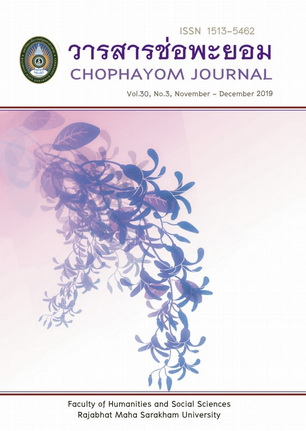Error Analysis in English Abstracts Written by Veterinary Students in Northeast Thailand
Keywords:
Abstract, Error, Veterinary Student, WritingAbstract
The present study was to 1) investigate types of errors in English abstract written by veterinary students in northeast Thailand and 2) analyze frequency and percentage of writing errors in their English abstracts. In total, 26 English abstracts were included in the study. Error analyses were performed both in sentential and word levels. The results demonstrated that they produced abstracts with approximately 157.58±38.15
words, 10.23±2.52 lines, and 16.65±8.83 points of writing error. Moreover, every abstract consisted of errors both in sentential and word levels. In total, 433 points of error were found and categorized in sentential and word levels for 238 and 195 points, respectively. Based on sentential level, errors included capital letter (88.0%), punctuation (47.0%), subject-verb agreement (46.0%), run-on (21.0%), fragment (19.0%), word order (9.0%), and tense (8.0%). Considering word level, errors included word choice (26.79%), preposition (8.78%), noun (7.16%), and article (2.31%). However, number error was not observed from any abstracts of the MSU veterinary students. In summary, the most eminent errors in sentential level were capital letter, punctuation,
and subject-verb agreement, meanwhile those in word level included word choice, preposition, and noun. The major reason of their writing errors was an insufficient linguistic knowledge, especially in syntax and semantics. Keywords : Abstract, Error, Veterinary Student, Writing
References
2.Alexandrov, A. V., & Hennerici, M. G. (2007). Writing good abstracts. Cerebrovascular Diseases, 23(4), 256-259.
3.Butler, L. (2007). Fundamentals of academic writing. New York: Pearson Education.
4.Cuschieri, S., Grech, V., & Savona-Ventura, C. (2019). WASP (Write a Scientific Paper): Structuring a scientific paper. Early Human Development, 128, 114-117.
5.Day, R. A., & Gastel, B. (2006). How to write and publish a scientific paper. Connecticut: Greenwood Press.
6.Dewan, P., & Gupta, P. (2016). Writing the title, abstract and introduction: Looks matter! Indian Pediatrics, 53(3), 235-241.
7.Driggers, R. G. (2010). How do you write a great abstract and why is it important? Optical Engineering, 49(6), 060101-060101.
8.Drubin, D. G., & Kellogg, D. R. (2012). English as the universal language of science: Opportunities and challenges. Molecular Biology of the Cell, 23(8), 1399.
9.Fletcher, R. H. (1988). Writing an abstract. Journal of General Internal Medicine, 3(6), 607-609.
10.Gustilo, L., & Magno, C. (2012). Learners’ errors and their evaluation: The case of Filipino ESL writers. Philippine ESL Journal, 8(9), 96-113.
11.Hengwichitkul, L. (2006). An analysis of errors in English abstracts translated by Thai university graduate students. (Master's Thesis), Srinakharinwirot University, Bangkok.
12.James, C. (1998). Errors in language learning and use. London: Longman.
13.James, C. (2013). Definition and delimitation. In Errors in language learning and use: Exploring error analysis (pp. 1-19). New York: Routledge.
14.Kaweera, C. (2013). Writing error: A review of interlingual and intralingual interference in EFL context. English Language Teaching, 6(7), 9-18.
15.Noojan, K. (1999). An analysis of errors in English abstracts of Srinakharinwirot University graduate students. (Master's Thesis), Srinakharinwirot University, Bangkok.
16.Phuket, P. R. N., & Othman, N. B. (2015). Understanding EFL students' errors in writing. Journal of Education and Practice, 6(32), 99-106.
17.Rhodes, W. T. (2010). The abstract as a marketing tool. Optical Engineering, 49(7), 070101-070101.
18.Runkati, K. (2013). Organizational patterns and common Mistakes in English research abstracts. (Master's Thesis), Prince of Songkla University, Songkla.
19.Simkhada, P., Van Teijlingen, E., Hundley, V., & Simkhada, B. (2013). Writing an abstract for a scientific conference. Kathmandu University Medical Journal, 11(3), 262-265.
20.Singh, C. K. S., Singh, A. K. J., Razak, N. Q. A., & Ravinthar, T. (2017). Grammar errors made by ESL tertiary students in writing. English Language Teaching, 10(5), 16-27.
21.Watcharapunyawong, S., & Usaha, S. (2013). Thai EFL students' writing errors in different text types: The interference of the first language. English Language Teaching, 6(1), 67-78.






